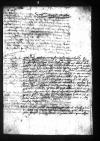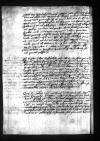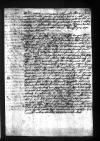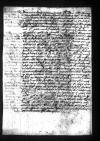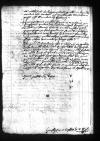Ex ⌊Bruxellis⌋ 1532-01-27⌊27 Ianuarii1532-01-27⌋ Serenissimae Maiestati Vestrae omnia, quae tunc se offerebant, ⌊⌋ satis diffuse. ⌊Inde⌋ me contuli ⌊Antverpiam⌋ et dispositis atque relictis ibidem rebus meis profectioni meae ⌊huc⌋ intendi malo tempore et pessimo itinere. Inter eundum conveni reverendissimum dominum ⌊cardinalem Leodiensem⌋, apud quem podagra me occupavit paululumque in ea remoratus, continuavi profectionem et tandem 1532-04-06⌊6 huius1532-04-06⌋ ⌊huc⌋ applicui ⌊⌋que Serenissimae Maiestatis Vestrae, quibus redeundi mihi dedit facultatem, magna animi cum alacritate perlegi habeoque, quas pectoris mei tenuitas potest, Serenissimae Maiestati Vestrae gratias immortales, quod tandem post octavum annum me exaudire dignata est hocque apud me habiturus sum perpetuo summi beneficii loco. Dominus Deus hanc in me Serenissimae Maiestatis Vestrae benignitatem immensa sua clementia Serenissimae Maiestati Vestrae rependat. Huc veniens nihil me neglexisse offendi, praeterquam quod litteras Serenissimae Maiestatis Vestrae caesari ipse non reddiderim, quod tamen etsi praesens fuissem, prae aegritudine et pedis dolore, quo adhuc
⌊maiestas eius caesarea⌋ laborat, vix assequi potuissem neque aliud tum ab illius maiestate obtinere de conventu oratorum in rebus Hungaricis quivissem, quam id, quod litteris suis Serenissimae Maiestati Vestrae perscripsit perstatque in ea sententia, ut conventus iste ⌊Patavii⌋ et non alibi fiat. ⌊Maiestatem eius⌋ hucusque alloqui non potui, neminem enim praeter domesticos admittit. Hodie mihi nuntiavit, ut moram adhuc patienter ferrem quousque aliquanto melius habere possit et quod pro me vult mittere, quando erit tempus. Ea, quae mihi visa sunt, ut ante meum exitum cum ⌊maiestate eius⌋ agam, congessi in memoriale, quod illi daturus sum, cuius his adiunxi exemplum, ex eo cognoscet Serenissima Maiestas Vestra, quomodo negotium illustris domini ⌊ducis in Prussia⌋ habeat, in quo facturus sum id, quod possum etc.
Quod ⌊caesar⌋ adeo difficulter admittere eos solet, qui colloquium petunt, ferunt causam esse, quod quidam humores pruritu leviusculo faciem eius invasere, hinc gravate se praebet videndum, nihilominus daturus sum omnem quam possum operam, res enim mea agitur, ut me quam primum hinc absolvam, quod tamen vix ante unius mensis decursum, dummodo certam aliquam expeditionem habere voluero, reor futurum. Velim enim et ad Serenissimam Vestram Regiam atque ad ⌊reginalem maiestatem⌋ cum certa aliqua rerum certitudine redire neque me movet, si etiam id, quod adhuc mihi reliquum est, impendam, certus de libertate redeundi.
Quae Serenissima Maiestas Vestra mandavit mihi scribi de magnifico domino ⌊Cornelio Sceppero⌋, nescio, si successum sunt habitura, quandoquidem dominus Cornelius ad praesens in curia non est, venturus tamen, ut mihi scripsit paulo ante, brevi. ⌊Maiestas caesarea⌋ in variis legationibus coepit iam pridem opera ⌊eius⌋ uti, unde continuus in hac esse aula non poterit. Ipse quid[em] (quemadmodum de mente ⌊eius⌋ certus sum) libenter cuperet rebus Serenissimae Maiestatis Vestrae inservire, sed cum nunc huc nunc
illuc mittatur, non poterit id, quod vellet, praestare. Videretur mihi satius, quod aliquis huc a Serenissima Maiestate Vestra mitteretur, qui ingenio et industria polleret. Hunc sic institutum hic relinquerem, quod commode negotiis Serenissimae Vestrae Regiae et ⌊reginalis Maiestatis⌋ inservire posset. Quamprimum tamen ⌊dominus Cornelius⌋ advenerit, ea cum illo agam, quae expedire videbuntur.
Scripsi 12 huius reverendissimo domino ⌊Cracoviensi episcopo⌋ ea, quae illustrissimum dominum ⌊Fredericum comitem palatinum Rheni⌋ concernunt. ⌊Is⌋ rogavit me, ut amplissimis se verbis Serenissimae Maiestati Vestrae excusarem, quod hucusque oratores suos non miserit et mentem suam declaraverit. Nollet enim, quod cum eo matrimonio, per ⌊caesarem⌋ et serenissimum ⌊Romanorum regem⌋ proposito, servitiis suis, quae utrisque longo tempore impendit, satisfieret.
1532-04-15⌊Heri1532-04-15⌋ apud me pransus est cum duobus suis fratribus ⌊Ottone Henrico⌋ et ⌊Alberto(!) episcopo Ratisbonensi⌋ atque cum illustrissimo et reverendissimo domino ⌊Ernesto duce Bavariae et episcopo Pataviensi⌋. Invitaverant se ipsos ad me pro honore Serenissimae Maiestatis Vestrae, quem ubi auctiorem et clariorem reddere possum, nihil moror meum commodum neque, ut mihi scribitur, in conviviis, quae hucusque feci non pauca eaque splendida, Serenissimae Maiestatis Vestrae et reginalis profundo pecuniam, quandoquidem illa ad ordinarium victum numquam mihi suffecit, sed meam, quam tamen ex gratia Serenissimae Maiestatis Vestrae habui et Deo bene favente ad dies meos habiturus sum ultimos. Neque me paenitet vel paenitebit umquam, si quid ad augmentum clarissimae apud omnes existimationis Serenissimae Maiestatis Vestrae et ⌊regni⌋ exposuerim, quamvis, ut mihi scribitur, nihil praeter verba et nullum commodum serenissimae ⌊reginali maiestati⌋ procuraverim, quod aliquando prodibit in lucem iuxta illud dictum:
cf. Vulg. 1Esr 4.32 et veritas magna et fortior prae omnibus ⌊omnium fortior est veritascf. Vulg. 1Esr 4.32 et veritas magna et fortior prae omnibus ⌋.
Post prandium illustrissimus dominus ⌊dux Fredericus⌋ multa iterum mecum fuit collocutus et manet adhuc in ea sententia, quam reverendissimo domino ⌊episcopo Cracoviensi⌋ descripsi. In his maxime rebus divina dominatur voluntas.
Pro cena heri invitavit me illustrissimus dominus ⌊Otto Henricus⌋ comes palatinus Rheni. Fuerunt cum eo tres episcopi Ratisbonensis, ⌊Pataviensis⌋ et Augustanus. Tractavit nos humanissime. Post cenam abduxit me seorsum in cubile suum et dixit, quod pro ea confidentia, quam de me concepisset, me rogaret, ut et scriptis et cum aliquando sospes ad Serenissimam Maiestatem Vestram redirem, non gravarer leniter et cum gratia Serenissimae Maiestatis Vestrae eandem Vestram Maiestatem commonere de dote, quae cum illustrissima olim Hedvigi, sorore Serenissimae Maiestatis Vestrae, debebatur, quam hereditario ad se iure devolutam dicebat et quod Serenissima Maiestas Vestra non sineret eum esse deterioris condicionis quam illustrissimus dominus ⌊Georgius dux Saxoniae⌋ et alii, qui Serenissimae Maiestatis Vestrae fuerant sororii, quibus magna ex parte iuxta promissum fuerat persoluta, offerens se in omnibus, quibus Serenissimae Maiestati umquam inservire posset. Haec, ut in notitiam Serenissimae Maiestati Vestrae deducerem, ⌊bono principi⌋ negare non potui, praesertim cum cognoscerem, quo animo ista peteret, inductus ab aliis, quod si matrimonium cum illustrissimo duce Frederico succederet, ne istiusmodi difficultas, quae prius fuit dotibus, fieret. Respondi, quae conveniebant, videlicet quod superioribus annis multae principes, una post aliam, ex ⌊regno Poloniae⌋ principibus ⌊Germaniae⌋ elocabantur et omnibus satisfieri non potuit, solere etiam magno numero ornari dotes, non persolvi et dixi me intellegere qua de re ista peteret, ut scilicet fratri duci Frederico commodaret, si forte succederet matrimonium. Nunc vero alia esse tempora et Serenissimam Maiestatem Vestram talem esse regem, qui non libenter cuiquam debet et quod semel dicit et concludit, servare solet omnibus, quam laudem ipse dominus dux ⌊Otto Henricus⌋ respondit Serenissimam Maiestatem Vestram passim habere ubique. Et sic ⌊bonus princeps⌋ humanissime in consortium episcoporum me rursus reduxit et inde amicissime dimisit.
Tractatur adhuc in ⌊Sweinfort⌋, ubi electores cum principibus Luteranis convenerunt. Fertur illos super propositis electorum dilationem ad deliberandum usque ad vigesimum huius cepisse. Hic hodie sollemnis missa debuit celebrari de Spiritu Sancto pro initio comitiorum, sed ⌊caesaris⌋ aegritudo fuit in culpa, quod non successit.
Postquam huc venissem, venit hic ad me ⌊quidam missus⌋ a magnifico domino ⌊Hieronimo Laski⌋ cum litteris ad me, in quibus mihi scripsit serenissimum ⌊Ioannem regem⌋ litteras dedisse ad ⌊caesaream maiestatem⌋, rogans me, quo efficerem, ut redderentur et ut responderetur. Scripsit item et serenissimo ⌊Romanorum regi⌋ ⌊caesari⌋que dominus ⌊Laski⌋, quas cum a nuntio recepissem, ne cognitus in discrimen aliquod incideret, misi primum litteras ad serenissimum Romanorum regem petebamque apud eius maiestatem admitti in colloquium, quo impetrato, dixi litteras ad me illas missas a rege Ioanne ad caesarem easque ostendi, petens, ut me de voluntate sua edoceret, quid cum his litteris mihi foret agendum, si vellet, ut remitterentur, unde venissent, vel ut caesari redderentur, me obsecuturum mandato maiestatis suae. Fuit illi mea ista oblatio admodum grata et inter alia respondit, quod alicui eas litteras darem, qui eas ferret ad ⌊caesarem⌋. Inde de negotiis serenissimae ⌊reginalis maiestatis⌋, ut ad ⌊caesarem⌋ intercederet, rogavi dedique memoriale conscriptum. Pollicebatur omnem operam. Diverti ab eo ad illustrem dominum ⌊comitem de Nassau⌋ et postulavi ab eo, ut de his litteris ⌊caesari⌋ diceret, ut me certiorem redderet, cui illas dari vellet. Rediens a ⌊caesare⌋ dixit caesarem respondisse, ut eas darem ⌊domino de Grannvela⌋, quod feci. In eis habetur excusatio ⌊Ioannis regis⌋, cur ad conventum Pataviensem non miserit. Nihil aliud est illis responsum, quam quod iam ⌊caesar⌋ Serenissimae Maiestati Vestrae
iam mentem suam declaraverit et quod nullo in loco conventus iste oratorum ad tractandam concordiam possit esse commodior quam ⌊Patavii⌋ etc.
Huc pervenit constans fama a ⌊Welseris⌋ et ⌊Fuggaris⌋, quibus ex ⌊Constantinopoli⌋ scriptum est ⌊Turcam⌋ 15 Martii praeteriti centum milia hominum praemisisse in ⌊Hungariam⌋ et se cum omni potentia subsecuturum. Nos tamen his novis parum hic movemur, nullos adhuc video apparatus, licet gloriose multa hic iactemus. Plaga Dei est. Et cum cubicularius iste Serenissimae Maiestatis Vestrae expeditus hinc tandem festinat et ego Deo bene favente brevi puto me apud Serenissimam Maiestatem Vestram futurum, ut etiam habeam, quod veniens coram referam, nolui ad praesens esse prolixior, sed hoc unum, quod restat, Serenissimae Maiestati Vestrae me ut domino meo clementissimo humillime commendo. Christus, Dominus noster, Illam quam diutissime sanam et incolumem atque felicissimam conservet.
